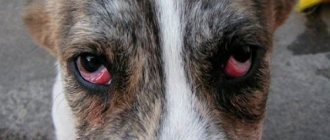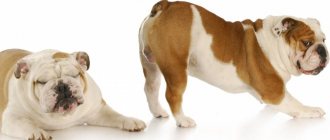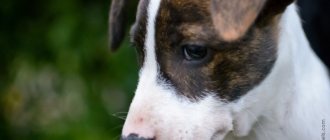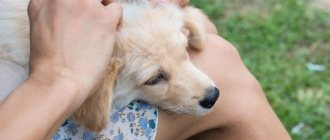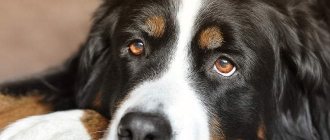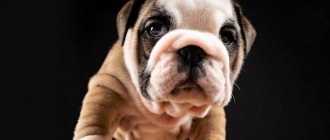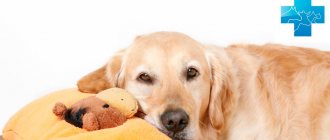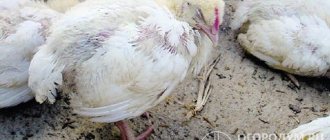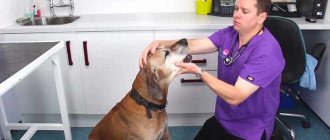A beautiful, shiny coat is one of the most important indicators of your pet’s good health. But what to do if your animal begins to develop bald spots? This condition of the pet's fur will definitely cause concern for an attentive, caring owner.
Alopecia is the term for hair loss and refers to any cause of hair loss, both internal and external, natural or not. It is important for the dog owner to understand the types of alopecia and know when to make an appointment at the clinic.
Classification of baldness
There is no generally accepted classification system for alopecia in pets; different sources divide the types of the disease in their own way. Experts agree that canine alopecia can be divided into three types, which also have their own subtypes:
- According to etiology, they are divided into 2 subtypes: inflammatory and non-inflammatory;
- Localization classification is divided into 4 subtypes: nested, telogen, mirror or multifocal;
- Genetics: hereditary and acquired (Alopecia X).
Veterinarians use this classification of the disease to make an accurate diagnosis in accordance with the standards.
Source of melatonin
Melatonin is easily synthesized and is therefore a fairly inexpensive hormone that is administered orally (as tablets or capsules) or systemically using subcutaneous injections or long-acting subcutaneous implants. Interestingly, melatonin is also present naturally in some plants. However, to absorb 3 mg of melatonin, you would need to eat 120 bananas or 30 large bowls of rice!
Melatonin tablets are sold over the counter in pharmacies and health products in the United States and some other countries, where it is considered more of a dietary supplement than a drug (so it is not regulated as such). Melatonin is available in 2 or 3 mg tablets under several trade names. However, only licensed products guarantee quality. Melatonin crystal powder is also made into capsules. The main problem with oral melatonin is its short half-life and dose-dependent bioavailability. In one study, after administration of 3 mg/kg IV, its half-life in dogs was 18.6 minutes. Thanks to the Rickards Research Foundation, injectable liquid melatonin (made from crystalline melatonin powder dissolved in ethanol and mixed with water and DMSO) has been available for several years. It has been used in the past to treat acanthosis nigricans (Scott et al., 1995). This could be a valuable option, although pharmacokinetic data on this are lacking. Long-acting implants containing 2.5 mg and 12 mg melatonin have been approved in several countries for use in mink and foxes, respectively. They are produced by WildlifePharmaceuticals. Unfortunately, some dogs that have received subcutaneous implants have developed sterile abscesses or granulomas at the implantation site. This is common in dogs; In the fur industry, more than 10 million minks and foxes received subcutaneous melatonin implants and there was no evidence of local adverse reactions.
Causes of alopecia in dogs
Depending on the type of baldness, the disease can have completely different causes. The most common cause is considered to be problems with hormones, so alopecia in dogs is still conventionally divided into two subtypes: hormonal and non-hormonal. Only in 40% of cases, hair problems arise for other reasons.
Problems with hormones
According to the latest data from veterinary scientists, it has been established that hormonal hair loss in dogs is associated with genetic problems. The official name of the disease Alopecia X means that the mechanisms of development of problems and transmission through genes are not fully understood. Today, transmission through an autosomal dominant relationship is considered the most likely.
Most often, adult and elderly dogs suffer from endocrine alopecia.
Hormonal problems can be caused not only by hereditary factors, but also by acquired ones. The most common causes of hormonal problems that cause baldness are diseases such as hypothyroidism and hyperandrenocorticism. In the first case, alopecia develops due to insufficient production of thyroid hormones, in the second - increased levels of cortisol (Cushing's syndrome).
Most often, the endocrine nature of alopecia leads to baldness on the abdomen and hind limbs, chest, anus and genital area, and armpit.
Seasonal molt
Changing coats in dogs is a natural process. The condition is characterized by systematic loss of old hair at certain times of the year. Shedding usually happens twice a year, but there are breeds in which it happens a little more often. It is easy to distinguish seasonal molting from pathological baldness by characteristic signs:
- Uniform hair loss without bald spots or bald spots;
- After combing, you can notice better quality wool of shorter length;
- Seasonality - loss occurs in spring and autumn;
- The dog's behavior has not changed.
Read Food allergies in dogs: how they manifest themselves, treatment methods and causes
When changing coat, the dog may itch a little; it is important not to confuse this symptom with the appearance of itching from other diseases. This process can be accelerated by systematically brushing the coat every day during the molting period.
Seasonal molting is not a disease and does not require any treatment. The hair loss should stop on its own within 2-3 weeks.
Poor nutrition
The cause of pet baldness can be an unbalanced diet with a lack of vitamins and minerals. Most often, coat problems appear in dogs that eat monotonous natural food. For healthy hair growth, the animal's body needs vitamins B and C.
Dogs that consume dry or canned food do not experience problems with hair loss due to a lack of vitamins. Typically, such feeding is saturated with useful substances.
Baldness after grooming
Dogs with hair growth problems experience problems with hair growth after clipping. In fact, slow coat growth is the first sign of accumulated problems. In this case, you need to contact a veterinary clinic and have your pet examined. The doctor will find out whether the lack of new hair is normal or a disease. If health problems are identified, it is necessary to change the animal’s diet and administer medication.
Allergic reactions
Allergic dogs suffer from patchy baldness due to the severe itching that accompanies the disease. The animal scratches the area of discomfort until bald patches appear. In this case, baldness is not due to hair growth problems, but is a secondary symptom of an allergy.
Allergies can be caused by food, pet care products, clothing materials, or seasonally flowering plants. In this case, the allergy is characterized by redness of the skin, and sometimes open wounds at the sites of irritation. The skin becomes dry and dandruff appears. It is difficult to identify the cause of an allergic reaction; you will need the help of a specialist.
Parasites
The presence of harmful parasites in the body often leads to thinning and hair loss in dogs. Alopecia develops as a consequence of helminthiasis, demodicosis, otodectosis or sarcoptic mange. In this case, parasites can be found both on the skin of the animal and in the internal organs.
Read Signs and treatments for vitamin deficiency in dogs: 9 vitamins your dog is missing
Parasitic diseases lead to a general deterioration in the health of hair follicles. Often parasites lead to severe itching on the dog's skin. The pet begins to itch a lot and symptoms of alopecia areata appear.
Stress
Dogs, like people, can experience stress; Chihuahuas and Labradors are most susceptible to such disorders. As a result of stressful situations, the animal's body experiences a multicomponent reaction in response to severe stress. Scientists have proven that this condition of the animal can lead to hair loss, among other things (Yang EV, Glaser R., 2001). The causes of stress are:
- Moving;
- First visit to exhibitions and competitions;
- Aggression from humans or other dogs;
As a result of stressful situations, the mildest form of alopecia develops - diffuse. Symptoms of the disease may not be noticeable and everything will return to normal on its own. Complications can arise if the pet experiences stress very often.
Pregnancy
The period of gestation of puppies itself does not cause baldness. Pregnancy entails a lack of vitamins in the pet’s body, hormonal imbalances and stress. During this special period, the cause of baldness may be one of the factors or all together.
To avoid alopecia in a dog during pregnancy, you need to improve the animal’s nutrition and ensure a quiet life, without unnecessary stress and close attention, especially from children.
Vitamins and preparations for hair restoration
A healthy dog has a beautiful, thick, even coat with bright color and shine. To ensure your pet’s appearance remains impeccable, its cover must be carefully monitored:
- Bath and brush according to breed recommendations;
- Use only animal-friendly products;
- Follow a diet, choosing high-quality products and feeds without allergenic additives.
During the shedding period, be sure to brush your dog daily to get rid of dead hair. Without this procedure, the pores become clogged, which leads to itching and irritation. If any unhealthy signs appear: bald spots, redness, you need to go to the clinic.
Another factor influencing the health of the coat is the sufficiency of the vitamin complex. All puppies and adult dogs need mineral supplementation. If dry food includes the necessary vitamins, then special additives are introduced for natural nutrition.
There are industrial wool growth tablets and nutritional supplements:
- Vit active S-SH (increasing hair density, improving structure; preventing destruction of hair follicles);
- Beafar (vitamin complex for healthy dermis and coat);
- Excel 8 in 1 (combination of garlic and brewer's yeast);
- Varieties of vitamins Canina ;
- Feed molasses and liver, flaxseed oil, brewer's yeast, lamb, whey (vitamins B, H, F);
Symptoms of alopecia in dogs
Each type of alopecia has its own characteristics, and there is no single clinical symptomatology. Depending on the cause and type of hair loss, dogs suffer from the following symptoms:
- Baldness due to hormonal imbalance is characterized by uniform or focal hair loss, as well as hyperpigmentation (Alopecia X).
- Seasonal shedding is characterized by uniform thinning and hair loss, but not completely.
- An unbalanced diet leads to alopecia in the form of severe thinning of the coat.
- After grooming, the symptom will be that the coat does not recover for a month.
- Allergies are characterized by alopecia areata, sores and redness in areas of baldness.
- Parasitic baldness manifests itself focally, the dog makes bald patches by scratching.
- Stress baldness is characterized by uniform loss and thinning of a dog's hair.
- During pregnancy, hair falls out evenly and the hair becomes thin. After childbirth, the fur is gradually restored.
Differential diagnosis based on the symptoms of alopecia is impossible; to determine the causes and type of disease, you need to contact a veterinary clinic where research will be carried out.
Hormonal disorders
Disturbances in the hair follicle cycle accompany most endocrine diseases and often lead to baldness:
- An increased content of estrogen - hyperestrogenism - makes the hair dull, brittle, the epidermis - thin, and the growth of new hair is delayed.
- The adrenocorticotropic hormone of the pituitary gland inhibits the development of fur.
- Hypothyroidism - a deficiency of thyroid hormones - leads to fragility of the skin, symmetrical alopecia, starting from the tail.
- In diabetes, metabolism is disrupted, the coat becomes dull and falls out.
Non-inflammatory alopecia due to endocrine disease
Alopecia due to hormonal imbalance is usually symmetrical.
Diagnostics
First of all, the veterinarian will perform an external examination of the dog and take an anamnesis. Next, the doctor will choose one of the diagnostic methods to detect alopecia in a pet:
- Biopsy;
- Phototrichogram;
- Glow with an ultraviolet lamp;
- Biochemical, mycological and bacteriological studies of skin scrapings;
- General analysis of blood, urine and feces.
Read Treatment of enteritis in dogs at home
An ultrasound may be prescribed to examine the functioning of the thyroid gland. The activity of B- and T-lymphocytes in the blood, the content of antigens and protein are being studied.
Infection or infestation (ringworm, mites, bacteria)
Ringworm, pests like scabies mites, and bacteria can all lead to infections that can eventually cause bald spots on your dog.
In addition to hair loss around the ears, eyes, mouth and other areas, your dog may have mite problems including oily skin, thickened skin, itching and inflammation. Symptoms of ringworm, a contagious infection of the hairy skin and nails, include circular or irregular hair loss, inflammation and infected crusts.
Although small ringworm lesions may go away spontaneously, they are contagious and require treatment. Ringworm is treated with topical antifungal medications. In severe cases, oral antifungal medications may be required.
Treatment for mites may require topical or oral medications, as well as antibiotics for secondary bacterial infections.
Best Treatments
Based on the diagnostic results, the veterinarian must prescribe appropriate treatment for the dog. There are general recommendations that are aimed at stimulating hair growth in dogs:
- Give the dog stimulating vitamins (Velkot, Polidex Super Wool);
- Increase the frequency of bathing your pet up to once a week;
- Masks of castor and burdock oil with egg yolks.
You should not give your dog human medications to stimulate hair growth (such as Minoxidil). The consequences of using such drugs can lead to the death of the animal.
After poor nutrition
Alopecia after an unbalanced diet requires a gradual increase in nutrients in the diet. Veterinarians recommend starting to give your dog fish oil, dairy products, seafood, and adding olive and flaxseed oil to his food. Vitamin complexes containing vitamin A can also be prescribed.
Treatment of hereditary hormonal alopecia
A genetic predisposition to baldness is formed due to hormonal problems. Therapy is carried out accordingly with hormones. The effectiveness of this therapy is low, so it is used in combination with the use of hair growth stimulating agents.
Contact or food dermatitis
This type of alopecia has an allergic etiology and side effects. It is treated with a complex of drugs prescribed by a veterinarian:
- Antihistamines (Diazolin, Diphenhydramine, Suprastin);
- Antiseptic ointments (Ranosan, Saphroderm, Septogel);
- Eliminating the allergen.
The use of such a complex of therapeutic measures helps eliminate the symptoms of baldness after 2-3 weeks. In advanced cases, independent treatment is impossible; the dog remains in the hospital.
Treatment for hair loss due to infection
The treatment regimen depends entirely on the type of infection that led to baldness. First of all, treatment is aimed at eliminating foreign bacteria, fungi and viruses from the body. Treatment is carried out with antiviral drugs.
Therapy for baldness from parasites
Treatment is aimed at eliminating helminths from the pet’s body that cause coat problems. Antiseptics are used to eliminate itching and prevent scratching. Further treatment is carried out using antiparasitic agents for animals, bathing, and enemas.
Contact, flea dermatitis
Inflammation of the skin, alopecia ends in the animal's sensitivity to household and medicinal allergens. Around the eyes (in the periocular region), hair falls out due to heavy discharge from the conjunctival sac. The diagnosis of “allergic conjunctivitis” is made by a veterinarian after a cytological examination of conjunctival scrapings that do not confirm atopy.
Allergic conjunctivitis in dogs
Paw dermatitis is caused by dry, cracking skin. The damaged epidermis does not prevent infections and allergens from penetrating deep into the skin.
Important! It is unacceptable to wash the animal with household detergents! Moreover, disinfectants! Such hygiene is a direct path to dermatitis and chemical burns. After a walk, wash the dog's paws with diluted shampoo - baby or dog shampoo.
Flea saliva can cause an allergic reaction in a dog's body. If the sensitivity to insect bites is high, and the infestation by ectoparasites is prolonged, then the skin turns red, swells, and partially or completely loses hair.
Flea dermatitis in a dog
A special dermatitis that leads, among other things, to baldness - a reaction to medications . An owner who takes on the functions of a diagnostician, doctor, or laboratory assistant is the scourge of a pet. An experienced, competent veterinarian, when prescribing treatment, will take into account:
- dog's age;
- coat type;
- stage of the disease;
- state of the body;
- drug compatibility and much, much more.
Self-medication is almost always ineffective and dangerous!!!
Therapy for contact dermatitis is the fight against secondary infection that attacks weakened skin, isolation from the allergen. Skin manifestations of intestinal dysbiosis are treated with diet.
Pet grooming
To quickly cope with this disease, it is extremely important to provide the dog with proper and complete care at home. It provides:
- Complete feeding of your pet. During the treatment period, it is recommended to give the dog food with a high content of vitamins, and to completely exclude from the menu all foods that can provoke allergies.
- Providing your pet with adequate rest and protection from stress. In case of infectious diseases, it is recommended to refrain from walking in public places and avoid contact with other animals, especially wild ones. If the dog lives in an enclosure, in a kennel, it is recommended to take him into the house and keep him there until he fully recovers.
- Use of a special protective collar. This remedy is used for severe itching to prevent the animal from scratching the skin. Effective if bald spots appear under the collar, on the face, around the eyes or ears.
- Regular brushing of your pet. Remember that fallen fur greatly irritates the skin and provokes intense shedding.
- The use of local drugs to relieve symptoms of pathology. If your doctor has not prescribed you an ointment, you can use olive oil for this purpose.
- Using special shampoos for bathing dogs. They must be selected by a veterinarian.
It is also extremely important to exclude the possibility of re-infection of the dog with parasites, pathogenic bacteria or fungi. To do this, you should treat the animal’s bedding (or replace it with a new one), its toys, bowls, and combs. The same should be done with the personal belongings of other animals living in the house.
Pregnant and lactating bitches suffering from hair loss should be provided with an enhanced diet. General medications are not used for such individuals, as they can negatively affect the development of the offspring. Sick puppies that have inflammation of the glands should be isolated from the rest of the litter. Otherwise, other babies can quickly catch an infection from them.
This type of care is provided until the dog fully recovers. After the symptoms of the disease disappear, he is again shown to the veterinarian. If he is satisfied with the condition of the animal, you can return to the normal rhythm of the animal’s life, remove restrictions on walking and choose a simpler diet for him.
Video: why does a dog lose hair, and what to do about it?
[custom_ads_shortcode2]
Allergy
Often, ear sores appear as a sign of a full-blown allergy caused by an unsuitable food product, care product or medication. Even a previously unused vaccine can provoke the onset of an allergic reaction.
Identifying the problem is quite simple:
- Redness occurs on both the inside and outside of the ear.
- Constant itching forces the dog to inflict unnecessary wounds on itself.
- General swelling appears.
- Discharge from the eyes.
If you are absolutely sure that the cause of your poor health is an allergic reaction, then you can get rid of it with the help of antihistamines and by eliminating contact with the thing that causes such symptoms.
Establishing diagnosis
It is impossible to independently determine the cause of canine alopecia, even with knowledge and practical experience. To make an accurate diagnosis, certain diagnostic procedures are required.
Before sending a four-legged patient for examination, the veterinarian assesses the condition of his skin and analyzes data received from the animal’s owner regarding how long ago this problem appeared, what symptoms it is accompanied by, whether the dog has suffered from any serious diseases in the past, and whether vaccinations are carried out regularly. and deworming. Information about the diagnostic procedures performed for dog hair loss is presented in the table:
Otodectosis
Ear mite damage is one of the most common causes of problems in domestic purebred dogs, since they have a much weaker immune system that does not protect against parasites. Even an animal that is not outdoors but comes into contact with other animals can become infected.
Almost all stray dogs are affected by this parasite.
Microscopic insects, falling on the inner surface of the auricle, bite under the skin and gnaw passages in it, feeding on particles of the epidermis and bloody secretions. Because of this, crusts and sores begin to form on the tips of the ears, and brown scabs appear, which are waste products of mites.
If the onset of infection is not noticed in time, then over time it will lead to the development of otitis media, and in particularly advanced cases it can provoke replenishment of the brain. Therefore, when you see the first mild signs of infection, you need to start taking action.
Additional signs of ticks are:
- Constant itching, disturbing the dog and forcing it to scratch the sore spot on all possible surfaces.
- Unpleasant smell.
- The appearance of sores and a gradual increase in their number.
- Too much dirt in the affected area.
When you contact the clinic, the doctor will take a scraping of the affected area of the skin and conduct the necessary examination, and then prescribe antiparasitic drugs and ointments.
If there is no opportunity to seek help at the moment, you can stop the proliferation of parasites by treating the sores with hydrogen peroxide, moving the pet to more comfortable conditions and increasing the diet.
Unbalanced diet
A lack of vitamins, amino acids and minerals leads to inflammatory reactions on the skin, itching, hair loss and flaking of the skin.
The main mistakes when feeding East European Shepherds (VEO) are as follows:
- Combination of natural and industrial feeding. Ready-made branded food is fully balanced in all nutrients. Therefore, if you supplement your dog with natural food, the balance is immediately disturbed.
- Self-feeding with vitamins. An incorrect selection of vitamins will lead to hypervitaminosis, which can also cause hair to fall out in clumps. If you want to give something to improve the condition of the coat, you can feed the dog an egg. It contains a lot of biotin, which is very beneficial for hair.
- The predominance of cereals in the diet. Dogs can easily tolerate porridge, but they are carnivores, so the most normal food would be meat and meat by-products. Therefore, you need to feed your German Shepherd tripe, lungs, kidneys, liver, bones and cartilage, and cottage cheese. Meat should prevail in the diet.
- Frequently feeding your pet liver. It has a very specific composition of proteins, amino acids, vitamins, and microelements. Therefore, frequent feeding leads to an imbalance of nutrients, which causes the shepherd to go bald.
- Feeding with fatty fermented milk products. Dogs' livers cannot digest cheeses, sour cream, cream and other foods with high fat content. You should also exclude pork from your diet, as it also contains a lot of fat.
Symptoms of feeding disorders are often the same:
- the shepherd itches and the hair falls out;
- gray hair;
- dandruff;
- bleeding gums;
- dryness, flaking of the skin;
- allergies.

